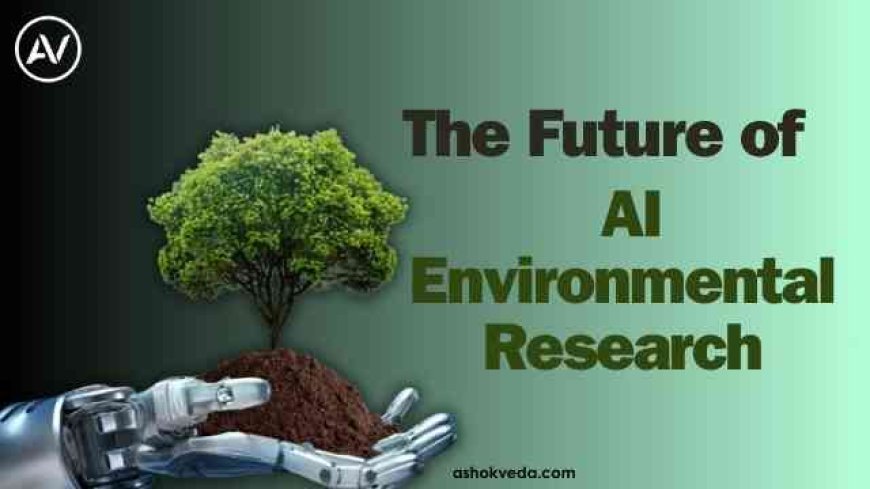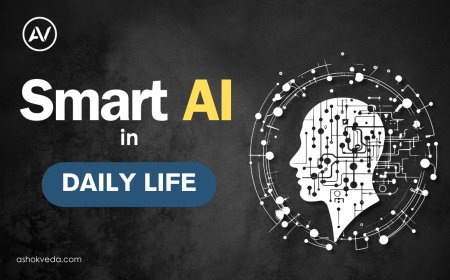The Future of AI in Environmental Research
Explore the role of AI in environmental research, focusing on advancements, applications, and the potential impact on climate and ecological studies.

Imagine a technology that helps us to protect the environment in innovative and interesting ways. AI in environmental research studies is making this a reality. Think AI systems that analyze huge amounts of data to predict climate change, track wildlife, and improve resource management. From drones recording actual time photographs of forests to AI models predicting pollution levels, the intersection of AI and environmental science leads to ground-breaking solutions. As we investigate how Artificial Intelligence may improve our efforts to rescue the environment, it becomes obvious that this technology holds the key to a healthier, greener future. how AI in environmental research is revolutionizing our approach to conservation and development.
The Role of AI in Environmental Research
AI has changed many industries, including environmental research. AI in environmental research uses modern algorithms, machine learning, and data analysis to address complicated environmental issues. By analyzing massive amounts of data, AI may find patterns and insights that humans would be able to recognize. This skill is transforming how we monitor environments, forecast environmental changes, and build sustainability plans.
1. Predicting Climate Change with AI
Climate modeling is one of the most important uses of Artificial Intelligence in environmental research. Traditional climate models use historical data and complicated simulations to forecast future climatic conditions. AI improves these models by processing massive datasets more efficiently and precisely. Machine learning algorithms can detect trends and create more accurate projections about climate patterns, allowing scientists and politicians to make educated decisions about climate action.
For example, AI may use satellite imagery to detect deforestation rates, monitor glacier melting, and assess coral reef health. This current information allows researchers to better understand how many elements contribute to climate change and devise tailored strategies to lessen its consequences.
2. Monitoring Wildlife with AI
Another exciting improvement in AI in environmental research is the application of AI to wildlife monitoring. Traditional techniques of monitoring animal numbers and habits can be time-consuming and limited in scope. AI-powered equipment, such as camera traps and drones outfitted with image recognition technology, can automate and improve wildlife monitoring.
These Artificial Intelligence systems can analyze photos and videos to identify species, count individuals, and follow movement patterns. This information provides important insights into animal behavior, migration patterns, and habitat utilization. For example, artificial intelligence has been used to monitor endangered species such as tigers and rhinos, assisting conservationists in protecting these creatures from poaching and habitat destruction.
3. Optimizing Resource Management with AI
Resource management is another area where AI in environmental research is having an important effect. Managing natural resources like water, energy, and land necessitates careful planning and efficient utilization. AI can improve resource management by assessing data on consumption, availability, and environmental impact.
AI algorithms can predict demand for resources, identify inefficiencies, and suggest improvements. For instance, AI can help manage water resources by predicting drought conditions, optimizing irrigation systems, and reducing water waste. Similarly, AI can enhance energy management by optimizing power grids, integrating renewable energy sources, and reducing carbon emissions.
The Future of AI in Environmental Research
As AI technology advances, its effect on environmental studies is projected to grow even more important. Here are some possible future advancements in AI for environmental research:
1. Combining IoT and AI
AI and the Internet of Things (IoT) together will make it possible to monitor environmental variables more thoroughly and in real-time. Data from multiple sources will be gathered by smart sensors and gadgets, and AI will analyze this data to produce insights that can be put to use. Our capacity to observe and react quickly to changes in the environment will be enhanced by this integration.
2. Better Predictive Analytics
More precise forecasts of environmental changes, like extreme weather, rising sea levels, and ecosystem transformations, are probably to come from future AI models. These forecasts will assist enterprises and governments in anticipating and lessening the effects of environmental change. Improving predictive analytics will be crucial to creating policies that effectively combat climate change and safeguard delicate ecosystems.
3. Personalized Environmental Solutions
AI may enable the development of personalized environmental solutions tailored to specific regions, communities, or individuals. For example, AI could help design custom conservation strategies based on local environmental conditions and needs. This personalization will ensure that environmental initiatives are more effective and relevant to the unique challenges faced by different areas.
4. Collaboration and Data Sharing
As AI technology becomes more accessible, collaboration and data sharing among researchers, organizations, and governments will increase. This collective effort will enhance the effectiveness of environmental research and drive progress in sustainability. Shared data and collaborative AI models will enable more comprehensive and coordinated responses to environmental challenges.
Challenges and Considerations
While the potential of AI in environmental research is vast, there are also challenges to address. Ensuring data privacy and security, addressing algorithmic biases, and managing the environmental impact of technology are important considerations. Researchers and practitioners must work together to develop ethical guidelines and best practices for using AI in environmental research.
-
Security and Privacy of Data
The gathering and examination of extensive datasets provide noteworthy obstacles concerning data security and privacy. It is crucial to make sure that private environmental data is shielded from abuse and illegal access. To preserve the integrity of their work, researchers must put strong data security safeguards in place and follow stringent privacy laws.
-
Taking Algorithmic Biases Aside
The quality of AI algorithms depends on the data they are trained on. Biases in the training set of data could cause the AI models to generate skewed output. For AI applications in environmental research to be impartial and reliable, it is critical to recognize and address these biases. When selecting a variety of representative datasets for AI model training, researchers must exercise caution.
-
Controlling Technology's Impact on the Environment
Artificial Intelligence has an environmental impact, even though it can help with environmental challenges. Degradation of the environment may result from hardware's electrical waste and AI systems' energy use. Researchers need to look at ways to recycle electrical components and use energy-efficient algorithms to make AI technology more sustainable.
The future of AI in environmental research holds tremendous promise for addressing the complex challenges facing our planet. From predicting climate change and monitoring wildlife to optimizing resource management and enhancing data collection, AI is transforming how we understand and protect the environment. As technology continues to evolve, the integration of AI will play a crucial role in advancing environmental research and promoting sustainability.
Researchers, technologists, or anyone concerned about the environment will find future uses of AI in environmental research interesting and full of opportunities. Accept the changes, keep up with the most recent advancements, and consider how AI may make the world better and more sustainable. The future is bright for individuals dedicated to positively impacting our world, and the adventure of combining AI with environmental studies is only getting started.




































